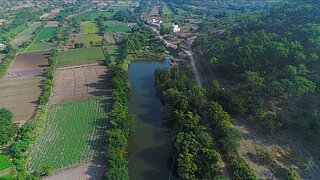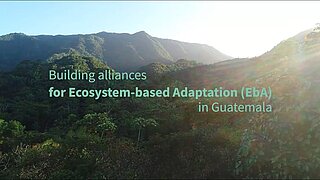Building wider support for EbA

Three key insights how improving communication about EbA can scale up the great potential of its approach.
Ample evidence from IIED and other organisations – along with the practical experiences of communities around the world – demonstrate that Ecosystem-based adaptation (EbA) (has great potential to help people adapt to climate change while delivering environmental, social and economic benefits.
For example, using EbA at the watershed level can drive changes at scale across diverse ecosystems. In addition, during the Covid-19 pandemic, we saw how communities that engage in EbA practices were better able to cope with its impacts, including loss of income and reliable access to food during lockdowns.
Those involved in EbA know that it works. But there is a need to build support and engagement among a wider range of stakeholders, including policymakers, funders and others with the capacity to facilitate EbA actions at scale, as well as at the community level. This work will allow us to build a more resilient society where both people and nature can thrive despite climate change.
Communicate vital EbA messages
How to communicate vital messages about EbA in order to foster widespread uptake beyond pilot projects was one of the topics up for discussion during the recent 15th International Conference on Community-based Adaptation to Climate Change. This yearly gathering of practitioners, grassroots representatives, local and national government planners, policymakers and donors working at all levels and scales hosted by TMG Research, Conservation South Africa, and the Watershed Organisation Trust aims to promote effective, locally led climate action.
As Dr Thorsten Klose-Zuber from the IKI Secretariat, remarked in his contribution, the need to address the “missing link” between small scale community-based activities and governmental policy plans is a vital point of discussion at the upcoming climate summit in Glasgow.
Describing the work of Conservation South Africa in community-owned rangelands which are home to many of the country’s poorest people, Sarshen Scorgie spoke of the value of developing decision-making structures that enabled communities to be the protagonists of EbA, and stewards of the landscapes in which they live. A community’s sense of ownership over EbA projects can be enhanced by the use of online tools such as StoryMaps, as demonstrated by Harriet Drani of IUCN. Larissa Stiem-Bhatia of TMG Research and Arjuna Srinidhi of WOTR described how their collaborative project, funded by IKI, used multi-stakeholder dialogues to build community buy-in for an evidence-based road map for scaling EbA in dryland regions of Maharashtra, India.
A key focus of all the contributors was on how to take these stories and evidence to others, especially policy-makers, other decision-makers, and private sector players.
Reflecting on the challenges, ideas, and solutions shared during the session, three key insights for improving communication about EbA stand out.
1. Being more explicit about benefits for each stakeholder group
Effective communication requires thinking about the aspects of EbA that will bring tangible improvements to the lives of the people that should be engaged. In the case of young people, jobs, the delivery of government services, and climate change are all important; our messages need to explain how EbA can bring benefits to them in all these respects.
This, of course, implies having a good understanding of the stakeholders and of their needs and interests, and looking strategically at the evidence base to come up with compelling messages that will increase their support for EbA.
To achieve this, it is necessary to identify how EbA can contribute to key policy objectives and to build narratives that spell out these potential benefits clearly. What are the ways in which EbA can support the Paris Agreement and the Global post-2020 Biodiversity Framework at the local, regional and national level? Similarly, if private sector actors are to be engaged, their intentions and priorities must be understood, and tailor EbA messages must be designed to pique their interest.
2. Using creative technologies and platforms
What is obvious for many can sometimes be difficult to convey to others. EbA is an integrated approach that builds on the interlinkages between nature, people and climate change, and it can be complicated to explain it clearly and succinctly.
Creative tools and methodologies that employ visual or multimedia means can help clarify what can be hard to communicate with words alone. Satellite or aerial images and videos, including those shot from drones, can help show what an ecosystem-based approach looks like to non-technical stakeholders. Storytelling approaches could help connect EbA to everyday experiences and help people understand how it works and to recognise its impacts. Videos are also a useful tool to convey local voices and perspectives to stakeholders.
Of course, there is no ‘one-size-fits-all’ tool or methodology. For example in some contexts, digital tools will not be accessible to all.
3. Facilitating collaboration
Communicating EbA requires to bridge the gaps between science, lived experiences and policy. It also needs to grapple with uneven power relations and with the limitations of voice and influence of some stakeholders. While communicating EbA needs to include all actors’ voices, there will be some perspectives that will need to be prioritised and boosted. For example, participants pointed to the need to support indigenous and local knowledge as part of diverse knowledge systems being central to how we communicate about EbA.
Communications can help build a more level playing field for all stakeholders, which is essential to build the type of collaboration needed to make EbA a more mainstream policy option. This includes facilitation and convening that is mindful of power dynamics, creating communications materials that are balanced and reflect the diversity of views and experiences, and doing the ‘homework’ of understanding where different stakeholders are coming from and how to bring them in the EbA tent. Communications of this kind can build the foundation for collaboration and fruitful EbA alliances.
EbA practitioners know very well how EbA approaches deliver benefits for people, nature and climate. For some years now, many practitioners have been telling powerful stories of how healthy ecosystems are helping people cope better with extreme weather events. The next task is to build political and societal support for EbA allowing it to be effectively scaled, building an even larger and greater EbA family.
Gabriela Flores, IIED & Harry Stopes, TMG Research
The link has been copied to the clipboard
Contact
IKI Office
Zukunft – Umwelt – Gesellschaft (ZUG) gGmbH
Stresemannstraße 69-71
10963 Berlin










![[Translate to English:]](/fileadmin/_processed_/2/e/csm_17_II_157_Pasabien_watershed__Guatemala__5___c__El_Fassi_4d01bf06a7.jpg)


